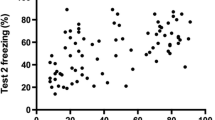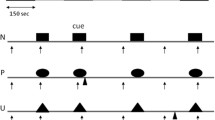Abstract
Rationale
LY354740, a structural analogue of glutamate that shows specificity at the mGluR2/3 receptor, has anxiolytic effects in animal models.
Objective
This study investigated the anxiolytic effects of LY354740 in humans using the fear-potentiated startle reflex methodology.
Methods
Subjects were given either placebo (n=16), 20 mg LY354740 (n=15), or 200 mg LY354740 (n=13). The fear-potentiated startle tests examined startle potentiation to shock anticipation and to darkness.
Results
Consistent with previous results, startle was increased by threat of shock and by darkness. LY354740 did not affect baseline startle. Correspondingly, subjects did not report LY354740 to be sedative. LY354740 significantly reduced the increase in startle magnitude during shock anticipation, but not during darkness. Subjective reports of state anxiety and negative affectivity during the fear-potentiated startle tests were also reduced in a dose-dependent manner by LY354740.
Conclusions
These results suggest that LY354740 has an anxiolytic profile in humans without being sedative.



Similar content being viewed by others
References
Baas JM, Grillon C, Bocker KB, et al. (2002) Benzodiazepines have no effect on fear-potentiated startle in humans. Psychopharmacology 161:233–247
Bitsios P, Philpott A, Langley RW, Bradshaw CM, Szabadi E (1999) Comparison of the effects of diazepam on the fear-potentiated startle reflex and the fear-inhibited light reflex in man. J Psychopharmacol 13:226–234
Charney DS, Heninger GH, Breier A (1984) Noradrenergic function in panic anxiety: effects of yohimbine in healthy subjects and patients with agoraphobia and panic disorder. Arch Gen Psychiatry 41:751–763
Dantzer R (1977) Behavioral effects of benzodiazepines: a review. Biobehav Rev 1:71–86
Davis M (1979) Diazepam and flurazepam: effects on conditioned fear as measured with the potentiated startle paradigm. Psychopharmacology 62:1–7
Davis M (1992) The role of the amygdala in fear and anxiety. Annu Rev Neurosci 15:353–375
Davis M (1998) Are different parts of the extended amygdala involved in fear versus anxiety? Biol Psychiatry 44:1239–1247
Davis M, Astrachan DI (1978) Conditioned fear and startle magnitude: effects of different footshock or backshock intensities used during training. J Exp Psychol [Anim Behav Proc] 4:95–103
Davis M, Redmond DE Jr, Baraban JM (1979) Noradrenergic agonists and antagonists: effects on conditioned fear as measured by the potentiated startle paradigm. Psychopharmacology 65:111–118
de Jongh R, Groenink L, van der Gugten J, Olivier B (2002) The light-enhanced startle paradigm as a putative animal model of anxiety: effects of chlordiazepoxide, flesonoxan and fluvoxamine. Psychopharmacology 159:176–180
Ferris P, Seward E, Dawson GR (2001) Interactions between LY354740, a group II metabotropic agonist and the GABA(A)-benzodiazepine receptor complex in the rat elevated plus-maze. J Psychopharmacol 15:76–82
Grillon C, Ameli R (1998) Effects of threat of shock, shock electrode placement, and darkness on startle. Int J Psychophysiol 28:223–231
Grillon C, Baas JM (2002) Comments on the use of the startle reflex in psychopharmacological challenges: impact of baseline startle on measurement of fear-potentiated startle. Psychopharmacology 164:236–238
Grillon C, Davis M (1997) Fear-potentiated startle conditioning in humans: explicit and contextual cue conditioning following paired vs. unpaired training. Psychophysiology 34:451–458
Grillon C, Morgan CA (1996) Fear-potentiated startle in Vietnam veterans with PTSD. Biol Psychiatry 39:555
Grillon C, Ameli R, Woods SW, Merikangas K, Davis M (1991) Fear-potentiated startle in humans: effects of anticipatory anxiety on the acoustic blink reflex. Psychophysiology 28:588–595
Grillon C, Sinha R, O'Malley SS (1994) Effects of ethanol on the acoustic startle reflex in humans. Psychopharmacology 114:167–171
Grillon C, Pellowski M, Merikangas KR, Davis M (1997a) Darkness facilitates the acoustic startle in humans. Biol Psychiatry 42:453–460
Grillon C, Ameli R, Goddard A, Woods S, Davis M (1997b) Baseline and fear-potentiated startle in panic disorder patients. Biol Psychiatry 35:431–439
Grillon C, Morgan CA III, Davis M, Southwick SM (1998) Effect of darkness on acoustic startle in Vietnam veterans with PTSD. Am J Psychiatry 155:812–8217
Grillon C, Sinha R, Ameli R, O'Malley SS (2000) Effects of ethanol on baseline startle and prepulse inhibition in young men at risk for alcoholism and/or anxiety. J Stud Alcohol 61:46–54
Helton DR, Tizzano JP, Monn JA, Schoepp DD, Kallman MJ (1998) Anxiolytic and side-effect profile of LY354740: a potent, highly selective, orally active agonist for group II metabotropic glutamate receptors. J Pharmacol Exp Ther 284:651–660
Hitchcock JM, Davis M (1986) Lesions of the amygdala, but not of the cerebellum or red nucleus, block conditioned fear as measured with the potentiated startle Kehne paradigm. Behav Neurosci 100:11–22
Kahneman D (1999) Objective hapiness. In: Kahneman D, Diener E, Schwarz N (eds) Well-being: the foundations of hedonic psychology. Russell Sage Foundation, New York, N.Y., pp 3–25
Kim M, Campeau S, Falls WA, Davis M (1993) Intra-amygdala infusions of the non-NMDA receptor antagonist CNQX blocks the expression of fear-potentiated startle. Behav Neural Biol 59:5–8
Klowsowicz BA, O'Donnell A, Volicer L (1979) Effects of ethanol on acoustic startle response and cerebellar cyclic GMP level: interaction with pilocarpine and atropine. Curr Alcohol 5:173–180
Kumari V, Cotter P, Corr PJ, Gray JA, Checkley SA (1993) Effect of clonidine on the human acoustic startle reflex. Psychopharmacology 123:353–360
Landis C, Hunt WA (1939) The startle pattern. Farrar and Rinehart, New York
Lang PJ, Bradley MM, Cuthbert BN (1990) Emotion, attention, and the startle reflex. Psychol Rev 97:1–19
Levine LR, Gaydos B, Sheehan D, et al. (2001) The mGlu2/3 receptor agonist, LY354740, reduces panic anxiety induced by CO2 challenge in patients diagnosed with panic disorder. Neuropharmacology 43:294
Lipp OV (2002) Anticipation of a non-aversive reaction time task facilitates the blink startle reflex. Biol Psychol 59:147–62
Patrick C, Berthot B, Moore J (1996) Diazepam blocks fear potentiated startle in humans. J Abnorm Psychol 105:89–96
Riba J, Rodriguez-Fornells A, Urbano G, Morte A, Antonijoan R, Barbanoj MJ (2001) Differential effects of alprazolam on the baseline and fear-potentiated startle reflex in humans: a dose-response study. Psychopharmacology 157:358–367
Rodriguez-Fornells A, Riba J, Gironell A, Kulisevsky J, Barbanoj MJ (1999) Effects of alprazolam on the acoustic startle response in humans. Psychopharmacology 143:280–285
Schoepp DD (1994) Novel functions for subtypes of metabotropic glutamate receptors. Neurochem Int 24:439–449
Shekhar A, Keim SR (2000) LY354740, a potent group II metabotropic glutamate agonist, prevents lactate induced panic response in panic-prone rats. Neuropharmacology 39:1139–1146
Spielberger CD (1983) Manual for the state-trait anxiety inventory. Consulting Psychologist Press, Palo Alto, Calif.
Tizzano JP, Griffey KI, Schoepp DD (2002) The anxiolytic action of mGlu2/3 receptor agonist, LY354740, in the fear-potentiated startle model in rats is mechanistically distinct from diazepam. Pharmacol Biochem Behav 73:367–374
Walker D, Davis M (1997a) Double dissociation between the involvement of the bed nucleus of the stria terminalis and the central nucleus of the amygdala in startle increases produced by conditioned versus unconditioned fear. J Neurosci 17:9375–9383
Walker DL, Davis M (1997b) Anxiogenic effects of high illumination levels assessed with the acoustic startle response in rats. Biol Psychiatry 42:461–471
Walker DL, Davis M (2000) Quantifying fear-potentiated startle: a comparison of absolute versus percent increase scoring methods. Soc Neurosci Abstr 26:482
Walker DL, Davis M (2002a) Light-enhanced startle: further pharmacological and behavioral characterization. Psychopharmacology 159:304–310
Walker DL, Davis M (2002b) Quantifying fear potentiated startle using absolute versus percent increase scoring methods: implication for the neurocircuitry of fear and anxiety. Psychopharmacology 164:318–328
Walker DL, Rattiner L, Davis M (2002) Group II metabotropic glutamate receptor within the amygdala regulate anxiety in rats as assessed with fear-potentiated startle. Behav Neurosci 116:1075–1083
Watson D, Clark LA, Tellegen A (1988) Development and validation of brief measures of positive and negative affect: the PANAS scales. J Person Soc Psychol 54:1063–1070
Woods JH, Katz JL, Winger L (1992) Benzodiazepines: use, abuse, and consequences. Pharmacol Rev 44:151–347
Acknowledgements
The authors acknowledge Lilly Research Laboratories for their financial assistance and for providing LY354740. The work was conducted at Yale University School of Medicine, Department of Psychiatry, New Haven, Conn., USA.
Author information
Authors and Affiliations
Corresponding author
Rights and permissions
About this article
Cite this article
Grillon, C., Cordova, J., Levine, L.R. et al. Anxiolytic effects of a novel group II metabotropic glutamate receptor agonist (LY354740) in the fear-potentiated startle paradigm in humans. Psychopharmacology 168, 446–454 (2003). https://doi.org/10.1007/s00213-003-1444-8
Received:
Accepted:
Published:
Issue Date:
DOI: https://doi.org/10.1007/s00213-003-1444-8




